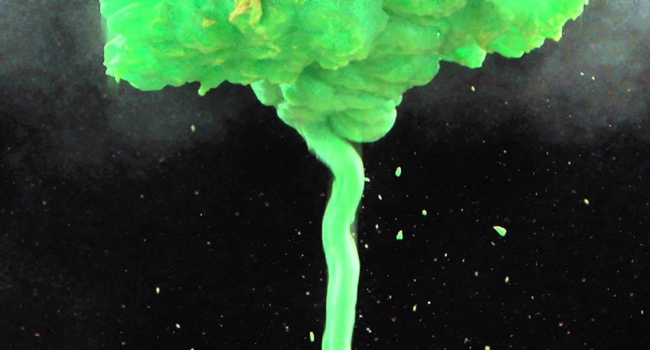90. tUnE-yArDs – w h o k i l l (2011):
 tUnE-yArDs (Merrill Garbus) has described her second studio release as an expression of modern dissonance, reflected both in the just-off sounds of w h o k i l l, and the album’s title itself (a reflection of our society’s overuse of “texting and emailing… when nothing is ever exactly right.” However, while this method of sloppy communication may lead to some off-putting emails and texts in real life, it leads to a unique sound that is exactly as magical as it is supposed to be. w h o k i l l is an absolutely riveting album, worthy of replay after replay of Garbus’s aggressive lyrics, masterful looping, exhilarating percussion, vaguely African melodic details, and fearless songwriting that constantly teeters on the edge of disintegration. tUnE-yArDs, through w h o k i l l, has found direct access to our guts. –Kelly Baron
tUnE-yArDs (Merrill Garbus) has described her second studio release as an expression of modern dissonance, reflected both in the just-off sounds of w h o k i l l, and the album’s title itself (a reflection of our society’s overuse of “texting and emailing… when nothing is ever exactly right.” However, while this method of sloppy communication may lead to some off-putting emails and texts in real life, it leads to a unique sound that is exactly as magical as it is supposed to be. w h o k i l l is an absolutely riveting album, worthy of replay after replay of Garbus’s aggressive lyrics, masterful looping, exhilarating percussion, vaguely African melodic details, and fearless songwriting that constantly teeters on the edge of disintegration. tUnE-yArDs, through w h o k i l l, has found direct access to our guts. –Kelly Baron
89. Animal Collective – Feels (2005):
 What makes Animal Collective one of the most ambitious and exciting bands currently active is their surreal-meets-the-understandable approach to music. It’s those tiny, strange little elements of their largely approachable sound that makes it so exhilarating and spectacular: the primal screeches in the chorus of “Grass,” the almost stoned auto harp on “Bees,” the gloriously languid progression of “Banshee Beat,” the fact that the entire album was tuned to their friend’s very out of tune piano. With these idiosyncrasies peppering such solid, listenable melodic structures, the indie world is seemingly always waiting for Animal Collective’s next release. And Feels is so special because it is the first album in which we see this approachability surface from their strangeness. This was the album where we heard their true songwriting abilities emerge and flourish, and it remains a testament to what huge and new sounds an album can accomplish sonically. –Kelly Baron
What makes Animal Collective one of the most ambitious and exciting bands currently active is their surreal-meets-the-understandable approach to music. It’s those tiny, strange little elements of their largely approachable sound that makes it so exhilarating and spectacular: the primal screeches in the chorus of “Grass,” the almost stoned auto harp on “Bees,” the gloriously languid progression of “Banshee Beat,” the fact that the entire album was tuned to their friend’s very out of tune piano. With these idiosyncrasies peppering such solid, listenable melodic structures, the indie world is seemingly always waiting for Animal Collective’s next release. And Feels is so special because it is the first album in which we see this approachability surface from their strangeness. This was the album where we heard their true songwriting abilities emerge and flourish, and it remains a testament to what huge and new sounds an album can accomplish sonically. –Kelly Baron
88. Kanye West – Graduation (2007):
 The triumphant conclusion to Mr. West’s “College Dropout” trilogy, Graduation further expands the prolific rapper’s scope. Where Late Registration boasted genre-hopping collaborations,Graduation boasted genre-hopping production. This is the album that made Daft Punk a household name (at least for households who listen to hip-hop and not Daft Punk), and the album that created common ground between Kanye fans and Coldplay fans. (The song “Homecoming” features guest vocals and a delicious piano hook from Coldplay frontman Chris Martin.) Each track sears with club-ready anthems, from the Young Jeezy-enhanced “Can’t Tell Me Nothing” to the sultry disco of “Flashing Lights.” Though Kanye might have left behind the R&B hooks that brought him to the forefront of hip-hop, he brings the genre into the future on Graduation. –John Taylor
The triumphant conclusion to Mr. West’s “College Dropout” trilogy, Graduation further expands the prolific rapper’s scope. Where Late Registration boasted genre-hopping collaborations,Graduation boasted genre-hopping production. This is the album that made Daft Punk a household name (at least for households who listen to hip-hop and not Daft Punk), and the album that created common ground between Kanye fans and Coldplay fans. (The song “Homecoming” features guest vocals and a delicious piano hook from Coldplay frontman Chris Martin.) Each track sears with club-ready anthems, from the Young Jeezy-enhanced “Can’t Tell Me Nothing” to the sultry disco of “Flashing Lights.” Though Kanye might have left behind the R&B hooks that brought him to the forefront of hip-hop, he brings the genre into the future on Graduation. –John Taylor
87. Grizzly Bear – Yellow House (2006):
 Before the sparse, cabin folk of Bon Iver and the lush, harmony-drenched Fleet Foxes made their respective breaks, Grizzly Bear made Yellow House. Certainly more abstract and complex in arrangement and execution, the quartet holds things together remarkably well. Melodies float above meticulous layers and dead space, sometimes falling out into free time before morphing back together. Chris Taylor’s production perfectly shapes the sound to that of an empty, dusty house out in the country, but that doesn’t mean the band can’t launch into heavily fuzzed-out sections with subtle electronics too. “Two Weeks” and the subsequent Veckatimest release may have garnered a larger fan base, but Yellow House remains a sonically mesmerizing, emotionally stirring release that has no peer. –Chris Favata
Before the sparse, cabin folk of Bon Iver and the lush, harmony-drenched Fleet Foxes made their respective breaks, Grizzly Bear made Yellow House. Certainly more abstract and complex in arrangement and execution, the quartet holds things together remarkably well. Melodies float above meticulous layers and dead space, sometimes falling out into free time before morphing back together. Chris Taylor’s production perfectly shapes the sound to that of an empty, dusty house out in the country, but that doesn’t mean the band can’t launch into heavily fuzzed-out sections with subtle electronics too. “Two Weeks” and the subsequent Veckatimest release may have garnered a larger fan base, but Yellow House remains a sonically mesmerizing, emotionally stirring release that has no peer. –Chris Favata
86. Refused – The Shape of Punk to Come (1998):
 Those that followed Sweden’s Refused from its early metallic-hardcore days would never have guessed the group would release one of punk rock’s crowning achievements. The album’s title boasts how highly the band viewed itself, but every track on this behemoth backs up the claim. The album is propelled by top-notch musicianship that sees Refused effortlessly switch between styles, never once stumbling over the weight of its own ambition. The Shape of Punk to Come flows together into one interlocking piece, where drum and bass breakdowns, spoken interludes, and free-form jazz find their way into this sprawling hardcore masterpiece. Refused has been often imitated, but never matched. Never has a swan song been more powerful or more blunt, “Refused Are Fuckin Dead.” –David Anthony
Those that followed Sweden’s Refused from its early metallic-hardcore days would never have guessed the group would release one of punk rock’s crowning achievements. The album’s title boasts how highly the band viewed itself, but every track on this behemoth backs up the claim. The album is propelled by top-notch musicianship that sees Refused effortlessly switch between styles, never once stumbling over the weight of its own ambition. The Shape of Punk to Come flows together into one interlocking piece, where drum and bass breakdowns, spoken interludes, and free-form jazz find their way into this sprawling hardcore masterpiece. Refused has been often imitated, but never matched. Never has a swan song been more powerful or more blunt, “Refused Are Fuckin Dead.” –David Anthony
85. And You Will Know Us By the Trail of Dead – Source Tags & Codes (2002):
 Nothing that the Austin quartet did before this, and nothing they’ve released since, has matched the impact of this record from beginning to end, their third full-length and first for a major label. Trail of Dead somehow located the sweet spot between art-rock, punk and noise and successfully integrated textures that alternated between screamo distortion and pianissimo orchestrations. But the record would not be as compelling (and listenable) without the strong songs, characterized by majestic, sprawling hooks, melodies worthy of head-bopping (at head-banging volume), and lead vocals at turns winsome, dead-pan casual and all-out chalkboard torture. Combine the sonic approach of their ancestors Sonic Youth and descendants Thursday, the goth-punk darkness of The Damned, the unhinged art seizures of Iggy Pop and the volume and speed of Hüsker Dü’s Zen Arcade, and that might provide a sense of what to expect from Source Tags & Codes. –Craig Bechtel
Nothing that the Austin quartet did before this, and nothing they’ve released since, has matched the impact of this record from beginning to end, their third full-length and first for a major label. Trail of Dead somehow located the sweet spot between art-rock, punk and noise and successfully integrated textures that alternated between screamo distortion and pianissimo orchestrations. But the record would not be as compelling (and listenable) without the strong songs, characterized by majestic, sprawling hooks, melodies worthy of head-bopping (at head-banging volume), and lead vocals at turns winsome, dead-pan casual and all-out chalkboard torture. Combine the sonic approach of their ancestors Sonic Youth and descendants Thursday, the goth-punk darkness of The Damned, the unhinged art seizures of Iggy Pop and the volume and speed of Hüsker Dü’s Zen Arcade, and that might provide a sense of what to expect from Source Tags & Codes. –Craig Bechtel
84. M83 – Dead Cities, Red Seas & Lost Ghosts (2003):
 Anthony Gonzalez seems intent on breaking down boundaries, both in music and in life: Boundaries between voices and instruments, dreams and reality, and perhaps most of all, the organic and the inorganic. Fittingly, Dead Cities, Red Seas & Lost Ghosts begins with a robotic voice coming out of the electronic abyss, presenting the listener with a seemingly ironic vision of sunshine, clouds, birds, and flowers. The voice is soon swallowed back into the void, giving way to bursts of synthesizers, drum machines, and orchestras. While human voices are only able to break through the noise for a few fleeting moments throughout the album, human emotion is far from lacking on Dead Cities. In fact, the lack of grounding in reality makes the music all the more potent. In the album’s final track, “Beauties Can Die,” a synthesizer crescendos over the top of a chorus of vocals. One cannot help but wonder if it is screaming or crying. –Derek Gossi
Anthony Gonzalez seems intent on breaking down boundaries, both in music and in life: Boundaries between voices and instruments, dreams and reality, and perhaps most of all, the organic and the inorganic. Fittingly, Dead Cities, Red Seas & Lost Ghosts begins with a robotic voice coming out of the electronic abyss, presenting the listener with a seemingly ironic vision of sunshine, clouds, birds, and flowers. The voice is soon swallowed back into the void, giving way to bursts of synthesizers, drum machines, and orchestras. While human voices are only able to break through the noise for a few fleeting moments throughout the album, human emotion is far from lacking on Dead Cities. In fact, the lack of grounding in reality makes the music all the more potent. In the album’s final track, “Beauties Can Die,” a synthesizer crescendos over the top of a chorus of vocals. One cannot help but wonder if it is screaming or crying. –Derek Gossi
83. Brand New – The Devil and God Are Raging Inside Me (2006):
 Really, The Devil and God Are Raging Inside Me was the end of an era. The emo wave was cresting in a big way, and Brand New were the flag bearers. Deja Entendu was the preparatory record, the next would be a record to define the scene. To legitimize it. The Devil and God was supposed to be vindication, but ended up being the exact opposite. It was heavy, rooted more in Vin Accardi’s tendency towards Jawbreaker style hardcore and Jesse Lacey’s obsession with being completely obtrusive. Brand New threw out most of the emo rulebook and built it up from (largely) scratch, bringing in pop (“Jesus Christ”), prog (“Limosuine”) and folk (“Handcuffs”) to augment what they correctly realized was a stale formula. Brand New saw the writing on the wall, and made one of the first, and best, post-emo records. –Tyler Remmert
Really, The Devil and God Are Raging Inside Me was the end of an era. The emo wave was cresting in a big way, and Brand New were the flag bearers. Deja Entendu was the preparatory record, the next would be a record to define the scene. To legitimize it. The Devil and God was supposed to be vindication, but ended up being the exact opposite. It was heavy, rooted more in Vin Accardi’s tendency towards Jawbreaker style hardcore and Jesse Lacey’s obsession with being completely obtrusive. Brand New threw out most of the emo rulebook and built it up from (largely) scratch, bringing in pop (“Jesus Christ”), prog (“Limosuine”) and folk (“Handcuffs”) to augment what they correctly realized was a stale formula. Brand New saw the writing on the wall, and made one of the first, and best, post-emo records. –Tyler Remmert
82. TV on the Radio – Dear Science (2008):
 Named the best album of 2008 by several major media outlets, Dear Science is one of the few albums that can stick to the claim of having something for every listener. The eclectic package that is TV on the Radio’s third studio album is a veritable cornucopia of sounds. From the Prince-like stylings of “Red Dress” that incites images of “Batdance” at points, to the hip-hop/electronica fun of “Dancing Choose,” Dear Science plays just as well to the club-goer as it does to sold out stadiums. And considering the diversity, it’s remarkably cohesive. A true album that features a little bit of it all. –Matt Wink
Named the best album of 2008 by several major media outlets, Dear Science is one of the few albums that can stick to the claim of having something for every listener. The eclectic package that is TV on the Radio’s third studio album is a veritable cornucopia of sounds. From the Prince-like stylings of “Red Dress” that incites images of “Batdance” at points, to the hip-hop/electronica fun of “Dancing Choose,” Dear Science plays just as well to the club-goer as it does to sold out stadiums. And considering the diversity, it’s remarkably cohesive. A true album that features a little bit of it all. –Matt Wink
81. Sigur Rós – Takk… (2005):
 Though the word “cinematic” gets thrown around a lot to describe bands of a whole variety of genres, it is probably best suited for the music of Sigur Rós, which has proven to everyone who doesn’t happen to be fluent in Icelandic that sometimes music in a foreign language can speak most deeply to the soul. Haunting melodies, sparkling piano, and beautiful orchestration combine to make “Takk…” (“Thanks…”) a dreamlike album from start to finish, all the more influential because it transcends meaning. It’s hard not to be inspired by the iconic opening of “Hoppípolla,” and it seems easier to imagine that the song is about being born or flying to the moon than, as its translated title indicates, “Jumping into Puddles.” In the end it doesn’t even matter – that’s the beauty of the album. –Leanne Howard
Though the word “cinematic” gets thrown around a lot to describe bands of a whole variety of genres, it is probably best suited for the music of Sigur Rós, which has proven to everyone who doesn’t happen to be fluent in Icelandic that sometimes music in a foreign language can speak most deeply to the soul. Haunting melodies, sparkling piano, and beautiful orchestration combine to make “Takk…” (“Thanks…”) a dreamlike album from start to finish, all the more influential because it transcends meaning. It’s hard not to be inspired by the iconic opening of “Hoppípolla,” and it seems easier to imagine that the song is about being born or flying to the moon than, as its translated title indicates, “Jumping into Puddles.” In the end it doesn’t even matter – that’s the beauty of the album. –Leanne Howard



